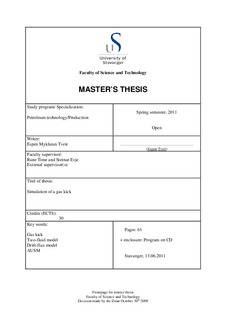| dc.contributor.author | Tveit, Espen Myklatun | |
| dc.date.accessioned | 2011-10-29T09:21:56Z | |
| dc.date.available | 2011-10-29T09:21:56Z | |
| dc.date.issued | 2011 | |
| dc.identifier.uri | http://hdl.handle.net/11250/183337 | |
| dc.description | Master's thesis in Petroleum engineering | no_NO |
| dc.description.abstract | In this paper a gas kick is simulated using a MatLab program for the purpose of showing several important phenomenons that occur during a gas kick. Pressure, flow rate in and out, fluid velocities and fluid fractions is studied to shed light on the fluid mechanics behind these phenomenons.
The base theory of the drift-flux model is explained based on the book by R. Time , for the purpose of demonstrating how a drift-flux model work before it is implemented in to the full MatLab scheme.
Based on the work done by Evje and Fjelde the two-fluid model together with the assumptions made in the model is explained. A hybrid of the flux-difference splitting scheme and the flux-vector splitting scheme is used in the model, based on AUSM and Van-Leer respectively. The reason of selecting this hybrid scheme is to be able to capture the fast propagating acoustic waves from the FVS scheme while avoid numerical dissipation by using the AUSM scheme.
MatLab setup for the model is explained in detail and who the different routines work together to make the model work. The main routine together with the sol_stian routine is given the most attention since these two routines are the biggest and most important in the model. After it has been established the function of every routine and how they work together in the model, it is explain where data must be changed in order to get the desired results from the model. A basic case is run to display how model function and what results the model produces.
The simulation is motivated by the paper written by Avelar et al where the pressures in the well and fluid flow rates are simulated. This case will be referred to as the reference case in this paper.
In the results from the simulation it is seen that model produces the phenomenon one would expect from a gas kick in a well. When correlating the results with the reference case it is seen that graphs the simulation yields can be assumed to be accurate, since they have about the same shape and characteristics. Hence the model and assumptions made to implement the case in the model is accurate. | no_NO |
| dc.language.iso | eng | no_NO |
| dc.publisher | University of Stavanger, Norway | no_NO |
| dc.relation.ispartofseries | Masteroppgave/UIS-TN-IPT/2011; | |
| dc.subject | petroleumsteknologi | no_NO |
| dc.subject | produksjonsteknologi | no_NO |
| dc.title | Simulation of a gas kick | no_NO |
| dc.type | Master thesis | no_NO |
| dc.subject.nsi | VDP::Technology: 500::Rock and petroleum disciplines: 510::Petroleum engineering: 512 | no_NO |
